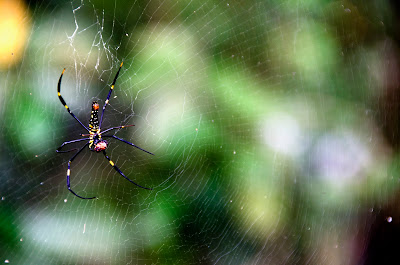On May 26th with the swell dropping off and restless feet I pointed the compass north and started off. I actually bought a compass and a road map. The map is missing many if not all minor roads including some new highways, has different names than those on the road signs, and has limited but not trivial function. The compass is actually a pretty useful tool, even if I'm not on the right road I can at least keep going the right direction until something makes sense. So yes, north. The center of Bali is mountainous with a couple volcanos visible from around the island on clear days. Gunung Agung is the tallest and most important to the Balinese. Before I leave I'm going to climb to the top which you begin at midnight to arrive at sunrise. Gunung Batur is the second tallest and Gunung Pohen the third. Both of these last two volcanos have lakes and towns at the top so the path was to go to the north coast via Batur and return via Pohen. I gave two days for the trip, one up, one back. I knew it gets cold at elevation but I didn't expect it to be as cold as it was as the sun set. Not to mention rainy, misty, and overcast, which wasn't a problem until the sun set and I was still on the northern descent down bumpy switchback roads. There seems to be more poverty on the mountains than along the coast, and the persistence of the vendors increases accordingly. Yet of all the things they were hawking the one thing I would have payed anything for was a jacket. But I didn't see any other traveler on a bike so maybe I'm niche market.
The calder is kilometers across, on the right you can see the center cone ascending but not the peak (I could never actually see the summit due to the cloud cover).

This is the weather over Lake Batur, only later did I learn that this area has Bali's coolest climate.
The volcano is active but not devastatingly so. The land around Lake Batur is fertile with most of the land covered in agriculture. The soil is dark, rich and aromatic of gardening, though the use of pesticides and fertilizers is on the rise here. I was told that years ago there was one rice harvest a year used for ceremonies and then the remainder was left, whereas now they have three a year and it is eaten for breakfast, lunch and dinner.
There are fisherman all over using an number of tools, from nets, to spears, that you can see here and dugout canoes which you can see below.
That's the center cone you can see in the background and a typical example of the dugout. There also seems to be aquaculture here.
As you descend into the caldera you have a choice at the bottom, left or right. Left is where the tourists go, as you get to the hot springs, climb the cone, and there's a village which has a different culture (so I was told) where they neither burn nor bury the dead. As we didn't go that way I can't confirm this. I went right, as from the rim of the caldera there were a number of villages and it looked the more interested considering I wasn't going to spend the night. This is the village at the end of the road. I arrived an hour before dusk and there were a number of people bathing in the lake. I don't think they expected to see a foreigner here, they were all naked so I averted my eyes and kept my camera by my side so as not to offend. As you drive you're basically replying to almost everyone "Helloooo!!!" and waiving. To numerous to count were the offers of guides along the way, for pay, of course. Essentially there's one road so you can't get lost, and they were heading home anyway but I rather just explore on my own.
The road, windy, steep on the side and gorgeous. Aquaculture in the background.
Ok, so on the way back to the road up to the rim at the final town before the ascent I saw this scene in what is by day a market. It looked to be the whole female contingent of the town doing aerobics to the direction of the most masculine woman or most feminine man I've yet seen. It was the first instance of exercise here outside of the occasional person running or riding a bicycle. This is a place where the influx of western fastfood and wealth has turned obesity into a common occurrence. Thirty years ago it was rare to see an overweight person, even last time I was here eight years ago it was rare. It's interesting because if you go to the mall, where everything is more expensive, you see more of it. As though weight follows wealth.







































